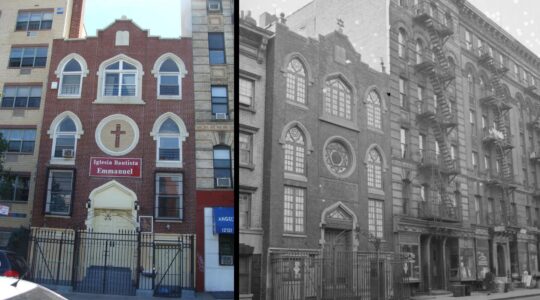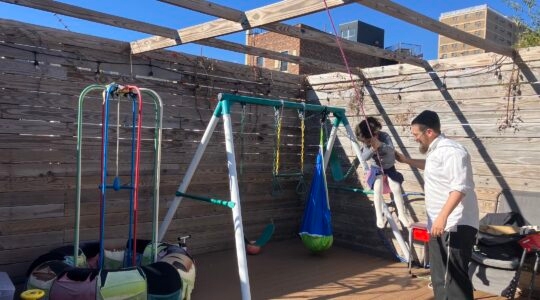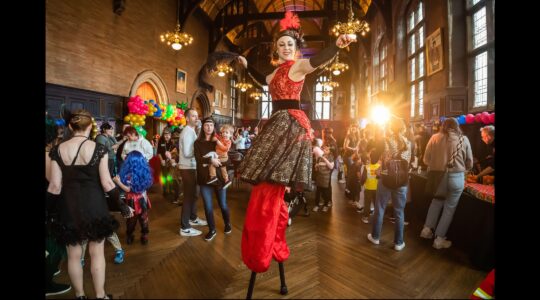I found this dvar Torah I wrote three years ago. When I wrote it then, I had certain patients in the hospital in mind. In rereading it today I am thinking about all those who are ill in the hospital, and all those who are working in the hospitals. I am thinking about the entire world learning how to stay at home and maintain a physical distance. How there are people who have not had anyone to interact with for over a month. How there are people who are not on our radars and don’t feel like they have anyone to call or anyone who will call them. How there are people who are choosing not to call their friends or families because they worry they will be too much of a burden. How there are people who even though things have gone primarily virtual, are not able to access it or even know about ways of connecting and interacting. How there are people who are feeling cut off and forgotten about.
In this time, may we continue to reach out and connect to those who feel disconnected. May we continue to be creative and innovative in our ways of connecting with others – and may we have the abilities of the Kohen, to try to connect with those who might have fallen through the cracks or might be not as simple to connect with.
You walk through one door and you are in the ante-chamber. In this room you wash your hands, put on a gown, gloves, and a mask. Only after that are you able to open the second door and enter into the isolation room. In this room is a person sitting alone on their bed. Their air is not circulated into the rest of the hospital. They do not have random people walking in by accident. They do not hear the hussle and bussle of the hospital floor. And everyone who comes in is fully covered, and likely won’t spend more than 30 minutes.
This person–sitting alone in quarantine, away from any sense of community– is the person we read about in this week’s parshiyot.
The Torah states:
יקרא י״ג:מ״ה-מ״ו
וְהַצָּר֜וּעַ אֲשֶׁר־בּ֣וֹ הַנֶּ֗גַע בְּגָדָ֞יו יִהְי֤וּ פְרֻמִים֙ וְרֹאשׁוֹ֙ יִהְיֶ֣ה פָר֔וּעַ וְעַל־שָׂפָ֖ם יַעְטֶ֑ה וְטָמֵ֥א ׀ טָמֵ֖א יִקְרָֽא׃ כָּל־יְמֵ֞י אֲשֶׁ֨ר הַנֶּ֥גַע בּ֛וֹ יִטְמָ֖א טָמֵ֣א ה֑וּא בָּדָ֣ד יֵשֵׁ֔ב מִח֥וּץ לַֽמַּחֲנֶ֖ה מוֹשָׁבֽוֹ׃ (ס)
(45) And the leper in whom the plague is, his clothes shall be rent, and the hair of his head shall go loose, and he shall cover his upper lip, and shall cry: ‘Unclean, unclean.’ (46) All the days wherein the plague is in him he shall be unclean; he is unclean; he shall dwell alone; without the camp shall his dwelling be.
The metzora, often translated as “the leper,” is told to both “dwell alone” and to “dwell without the camp.” They are forced to not only be alone, but to leave everyone and everything that they know in order for them to find healing.
According to the Da’at Zekeinim, the metzora must leave the camp because his disease is contagious; he must leave so no one else will become inflicted.
There are other commentaries that say the person must leave the camp in order to repent and learn from their ways. The rabbis try to make this time outside the camp a time for growth and change, I can’t help but think that this time can also be one of great difficulty. Although there are times when we might desire a bit of “alone time,” or just some peace and quiet away from “the world,” it is actually very hard to truly be cut off, or even feel cut off, from everyone and everything (just think how the digital age has made this even harder).
Although there are times when we might desire a bit of “alone time,” or just some peace and quiet away from “the world,” it is actually very hard to truly be cut off, or even feel cut off, from everyone and everything (just think how the digital age has made this even harder).
Most people don’t really want to be completely alone. There is a reason why isolation can be used as one of the greatest forms of punishment. We are social beings by nature. As people, we need, we crave human interaction. I would go so far as to say we need relationships. Simply being around other people is not enough. We need that deep connection of a relationship because sometimes being around others can be the loneliest moments.
Over time, the metzora is healed because their physical ailment went away or because they did real teshuva and have become deserving of re-entering the community. In order to be brought back, a Kohen must go to retrieve him and accompany him back. It is specifically a Kohen, the holiest family in the community, who exile and welcome back the metzorah.
There is a story in Mesechet Sanhedrin (98a), where Rabbi Yehoshua ben Levi sees Eliyahu, and asks him when Mashiach will come. Eliyahu responds that he will be able to find Mashiach by the gates of the city, changing the bandages of the lepers.
There is a story in Mesechet Sanhedrin (98a), where Rabbi Yehoshua ben Levi sees Eliyahu, and asks him when Mashiach will come. Eliyahu responds that he will be able to find Mashiach by the gates of the city, changing the bandages of the lepers.
Here again we see a person that we hold to the greatest esteem, Mashiach, the savior, sitting with those who are on the outside and in the most pain. It had to be the Kohen to go out to greet the lepers, and it has to be Mashiach that sits with the lepers, because it is only then that we are able to learn that we, as lay people, have the obligation to help those isolated from the community. Reaching out cannot be seen as beneath us.
The time between Pesach and Shavuot, Sfirat HaOmer, is filled with days of both celebration and commemoration. Out of these seven weeks, only one does not have a holiday or a day of commemoration.
The first of these days after Pesach is Yom HaShoah, Holocaust Remembrance Day. A day in which we are called upon to look and remember the horrors that befell our families, the Jewish People as a whole, and our fellow human beings. Moreover, it is time when we, as Jewish people, were separated out, and never welcomed back in.
Just a week later have the commemoration of Yom HaZikaron, immediately followed by the celebration of Yom Ha’Atzmaut. First we take the time to mourn those who have been killed in acts of terror or in the line of duty defending Israel. It is a time that many are able to share their mourning with others. If you have every been in Israel during this time then you know, when walking in the streets of Israel on this day, everyone is a mourner and everyone is a comforter. Though it is a difficult day for everyone, everyone finds a way to reach out to offer comfort.
And on that very evening, when the nation has already joined together in a time of great sadness, they all transition together into a time of celebration. The people take their unity, forged in memory of the fallen, and use it to celebrate the creation of the nation, to celebrate a people coming together and becoming more than themselves–become a community and a nation despite where they might have come from.
Next is Lag Ba’Omer. Traditionally, this is the day that the students of Rabbi Akiva stopped dying. Until that day, a plague had befallen them because of sinat chinam, because they were unable to treat one another kindly, as is said in Yevamot 62b. The rabbis teach that a person would get tzarat was because they would not share with those who were in need, they would trick people with their measurements, or they would speak slander. It was during the time of Lag Ba’omer that the students stopped dying. The students were able to take a moment and come together again as a community.
After that is Yom Yerushalim, Jerusalem reunification day. A day, if you speak to people who were living in Israel at the time, that was a game changer for how the city of Jerusalem functioned. It was a time that the city was no longer isolated. That they would not be cut off from the rest of the country.
Finally we have Shavuot. In the times of the Beit HaMikdash, farmers would bring their first fruits, Bikurim, to the Kohen and say
אֲרַמִּי֙ אֹבֵ֣ד אָבִ֔י וַיֵּ֣רֶד מִצְרַ֔יְמָה וַיָּ֥גָר שָׁ֖ם בִּמְתֵ֣י מְעָ֑ט וַֽיְהִי־שָׁ֕ם לְג֥וֹי גָּד֖וֹל עָצ֥וּם וָרָֽב׃
“My father was a fugitive Aramean. He went down to Egypt with meager numbers and sojourned there; but there he became a great and very populous nation.” (Devarim 26:5)
For 49 days, seven weeks, we count. From the day (give or take) we left Egypt we have been counting until we received divine revelation from Hashem as a whole nation at once. We go from a small family, to a nation of slaves, and finally realize ourselves as a free people, united and bonded not simply by blood but also by a community under Hashem and the Torah.
Although Tzaria-Metzora can fall at different points of the year, I think it has a message for us right now, especially during the time of the Omer which brings ancient and modern days of celebration and commemoration together.
We must look outside of ourselves–even our small, tight community–and see what is happening all around, outside our “camps” and “gates.” It is very easy for us to be in our spaces that make us feel comfortable, for us to be around others who are on the inside or who are seemingly happy. But we have to push ourselves to leave our comfort zones, to even peek outside our encampments we have made. We need to become aware of the many who are outsiders or who might feel like outsiders. It is up to each one of us, from the greatest to the smallest and meekest of us, to go out and embrace and welcome those outsiders, grieving in their loneliness, into our communities.
We must look outside of ourselves–even our small, tight community–and see what is happening all around, outside our “camps” and “gates.” It is very easy for us to be in our spaces that make us feel comfortable, for us to be around others who are on the inside or who are seemingly happy. But we have to push ourselves to leave our comfort zones, to even peek outside our encampments we have made.
It is in these laws of the metzorah, I believe, that we can learn that it is up to us to seek out those who feel alone or isolated and offer them comfort and community. It does not matter if they are isolated because of something they are able to control or not. One does not only need to create a space for people to feel comfortable and welcome, but one must also find a way to start the welcoming process. It is our job to “go out of the camp,” to pick up a phone or send out an email so someone that is outside of our camp will have a way in.
Shabbat Shalom & Chodesh Tov!
Rabbi Eryn London is the JOFA UK Scholar In Residence.
Posts are contributed by third parties. The opinions and facts in them are presented solely by the authors and JOFA assumes no responsibility for them.
If you’re interested in writing for JOFA’s blog contact dani@jofa.org. For more about JOFA like us on Facebook or visit our website.
The New York Jewish Week brings you the stories behind the headlines, keeping you connected to Jewish life in New York. Help sustain the reporting you trust by donating today.




